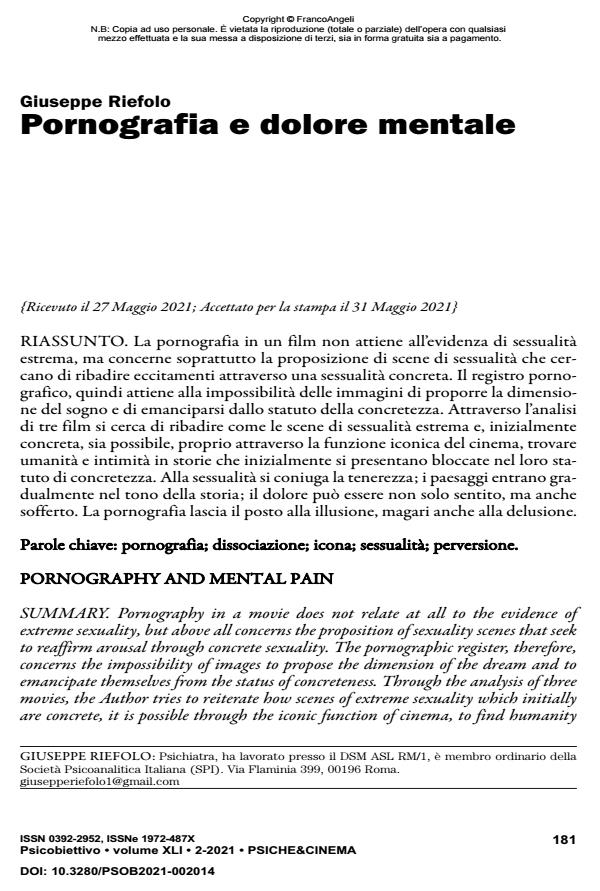Pornography and mental pain
Journal title PSICOBIETTIVO
Author/s Giuseppe Riefolo
Publishing Year 2021 Issue 2021/2
Language Italian Pages 10 P. 181-190 File size 113 KB
DOI 10.3280/PSOB2021-002014
DOI is like a bar code for intellectual property: to have more infomation
click here
Below, you can see the article first page
If you want to buy this article in PDF format, you can do it, following the instructions to buy download credits

FrancoAngeli is member of Publishers International Linking Association, Inc (PILA), a not-for-profit association which run the CrossRef service enabling links to and from online scholarly content.
Pornography in a movie does not relate at all to the evidence of extreme sexuality, but above all concerns the proposition of sexuality scenes that seek to reaffirm arousal through concrete sexuality. The pornographic register, therefore, concerns the impossibility of images to propose the dimension of the dream and to emancipate themselves from the status of concreteness. Through the analysis of three movies, the Author tries to reiterate how scenes of extreme sexuality which initially are concrete, it is possible through the iconic function of cinema, to find humanity and intimacy in stories that initially appear blocked in their status of concreteness. Tenderness is combined with sexuality; landscapes gradually enter the tone of the story; the pain can be not only felt, but also suffered. Pornography leaves space to illusion and perhaps even disappointment.
Keywords: pornography; dissociation; icon; sexuality; perversion.
- Balint M. (1968) La regressione, Raffaello Cortina, Milano, 1983
- Benjamin J. (2017) Il riconoscimento reciproco, Raffaello Cortina, Milano 2019 Bion W.R. (1970) Attenzione e interpretazione, Armando, Roma, 1973
- Bollas Ch. (1999) Il mistero delle cose, Raffaello Cortina, Milano, 2001
- Breuer J., Freud S. (1892-1895) Studi sull’isteria, OSF, Vol. 1, Bollati Boringhieri, Torino
- Bromberg Ph.M. (1998) Clinica del trauma e della dissociazione, Raffaello Cortina, Milano, 2007
- Bromberg Ph.M. (2006) Destare il sognatore, Raffaello Cortina, Milano, 2009
- Bromberg Ph.M. (2011) L’ombra dello tsunami, Raffaello Cortina, Milano, 2012
- Fairbairn W.R. (1954) “Osservazione sulla natura degli stati isterici”, in Il piacere e l’oggetto, Astrolabio, Roma, 1992
- Freud S. (1915) Pulsioni e loro destini, OSF, vol. 8, Bollati Boringhieri, Torino
- Gaburri E. (2007) Tenerezza e Réverie. Intervento presso il Centro di Psicoanalisi Romano, 4 maggio (darttiloscritto)
- Howell E.F. (2016) “Models of dissociation in Freud’s work. Outcomes of dissociation of trauma in theory and practice”, in Howell E.F., Itzkovitz S. (eds.), The dissociative mind in psychoanalysis, Routledge, London-New York
- Kohut H. (1971) Narcisismo e analisi del Sé, Bollati Boringhieri, Torino, 1976
- Kohut H. (1984) La cura psicoanalitica, Bollati Boringhieri, Torino, 1986
- Manara M. (2021) “Alba Solaro: Milo Manara. Questa volta mi metto a nudo io”, Il Venerdì, 16 aprile
- Ogden Th.H. (2007) “Sul parlare come sognare”, in Riscoprire la psicoanalisi, CIS, Milano, 2009
- Riefolo G. (2005) “Per via di immagini”, in A. Ferruta (a cura di), Pensare per Immagini, Rivista di Psicoanalisi (monografie, 3): 43-57
- Slochover J. (2014) Collisioni psicoanalitiche, Ferrari Sinibaldi, Milano, 2015
- Stern D. (2004) Il momento presente, Raffaello Cortina, Milano, 2005.
- Stolorow R.D., Atwood G.E. (1992) I contesti dell’essere, Bollati Boringhieri, Torino, 1995
Giuseppe Riefolo, Pornografia e dolore mentale in "PSICOBIETTIVO" 2/2021, pp 181-190, DOI: 10.3280/PSOB2021-002014